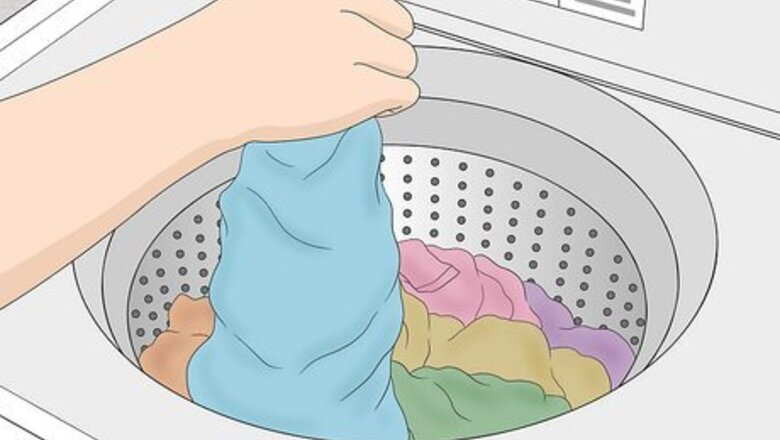
views
- Place your clothes in the washer, start the hottest cycle, and add 1 cup of either white vinegar, baking soda, or Borax into the water.
- Then, hang your clothes outside in the sun to dry.
- For clothes that are dry-clean only, sprinkle them with baking soda and leave them in a plastic bag overnight. Or, set them in a plastic bag in your freezer overnight.
Treating Machine Washable Clothes
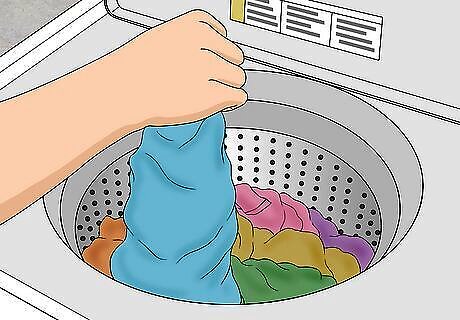
Put your clothes in the washer and start the hottest cycle. Place your musty-smelling clothes in your washing machine and add the recommended amount of laundry detergent for the size of your load. Then, turn on your machine to its hottest setting, start it, and let the washer fill with water. The hot water helps kill any mold or mildew spores on your clothes. If your clothes can’t be washed in hot water, use warm or cool water instead. You might have to wash the clothes more than once to get rid of the smell.
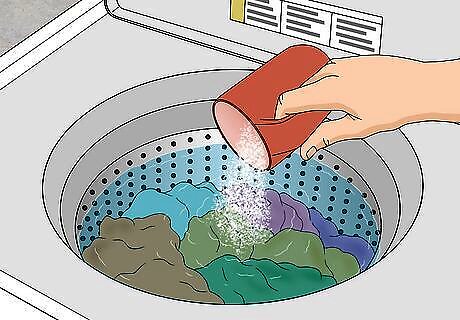
Pour 1 cup of white vinegar, baking soda, or Borax into the water. Vinegar, baking soda, and borax are all-natural cleaners that neutralize odors and can disinfect any mildew or mold spores that are causing the musty smell. When the washer completely fills with water, add in either 1 cup (237 ml) of vinegar, 1 cup (272 g) of baking soda, or 1 cup (204 g) of Borax. Then, close the washing machine door and finish running the wash cycle. For front-loading machines: Pour the vinegar into the fabric softener dispenser before you start the washer. If you’re using baking soda or Borax, sprinkle it directly on the clothes before you start the machine. These products are also safe on delicate fabrics, unlike bleach. If your clothes are very musty smelling, use 2 cups (473 ml) of vinegar. Or, do a wash cycle with vinegar and then a wash cycle with baking soda. EXPERT TIP Susan Stocker Susan Stocker Green Cleaning Expert Susan Stocker runs and owns Susan’s Green Cleaning, the #1 Green Cleaning Company in Seattle. She is well known in the region for outstanding customer service protocols — winning the 2017 Better Business Torch Award for Ethics & Integrity —and her energetic support of green cleaning practices. Susan Stocker Susan Stocker Green Cleaning Expert Our Expert Agrees: The best way to deodorize your clothes is to wash them after each wearing. It's much easier to remove odors if there's not a build-up. If you do have strong odors, add a cup of vinegar to your wash for an all-natural deodorizer.

Hang your clothes outside to dry. Place your clothes on a clothesline or drying rack in a spot outdoors that gets full sun and lots of airflow. The sun’s UV rays help kill any remaining mold or mildew spores while the air adds a fresh scent to your clothes. If it's humid, wet, or cold and cloudy outside, use a dryer instead. Just set it to medium or high heat to eliminate any leftover mold or mildew spores. If your clothes come out of the dryer still smelling musty, wait for a sunny day to wash them and then dry them outside.
Treating Dry-Clean Only Items
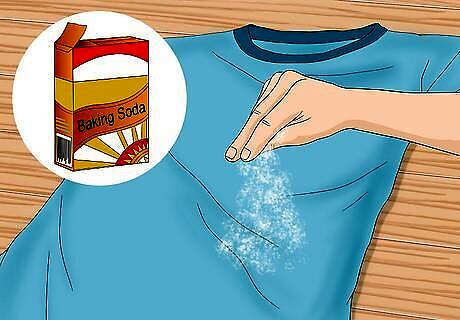
Apply baking soda onto your clothes and set them in a bag overnight. Baking soda absorbs the musty smell on your clothes even when they’re dry. Just apply a fine layer of baking soda on the front and back of your clothes. Then, place your clothes in a sealed plastic bag or container and leave them to sit overnight. In the morning, shake out or brush off the baking soda. To add a fresh scent to your clothes, hang them outside for the rest of the day.
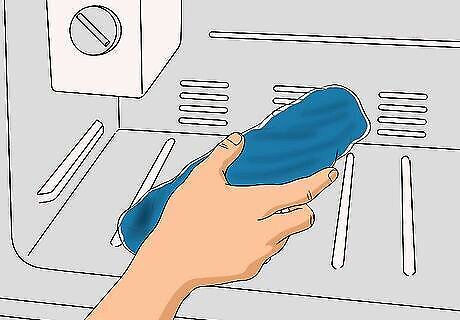
Set your clothes in the freezer overnight. Freezing your clothes kills any bacteria or mold and mildew spores that might leave them smelling musty. Just tightly roll up your clothes and place them in a freezer-safe plastic bag or container. Then, leave them in the freezer for at least 2 hours, or overnight. Hang up your clothes outside to defrost and dry them.
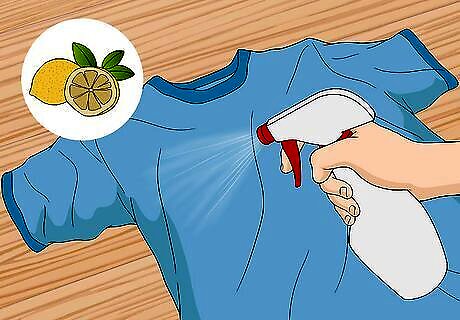
Spritz white clothes with lemon juice to deodorize and brighten them. Lemons are natural deodorizers that you likely already have sitting in your kitchen. They also work similarly to bleach and can leave white towels and clothes looking fresh. Just squeeze the juice of several lemons into a spray bottle and spray your musty, white clothes until they’re slightly damp. Then, hang your clothes outside in the sun until they’re dry. Lemon juice can stain and bleach colored fabrics, so only use it on white clothes. Diluting the lemon juice in water can make it more color-safe. Just spray a concealed part of your garment to make sure it doesn’t bleach it before misting it all over.
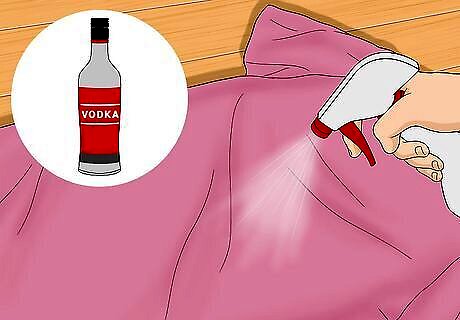
Spray your garments with vodka. Vodka isn’t just a tasty alcoholic drink—it can neutralize odors and kill bacteria and germs on your clothes. Simply pour some vodka into a spray bottle and spray the musty garment all over until it’s slightly damp. Then, hang it outside in the sun to dry.
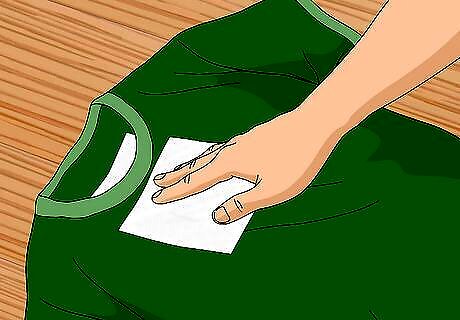
Place dryer sheets between your musty clothes. Dryer sheets can lift odors and add a pleasant scent to your clothes. Just fold and stack your smelly garments and place a dryer sheet in between each article of clothing. Leave the dryer sheets be for about 1 day and then remove them for clean, fresh-smelling clothes. This is also a great solution for preventing musty smells if you’re storing your clothes away.
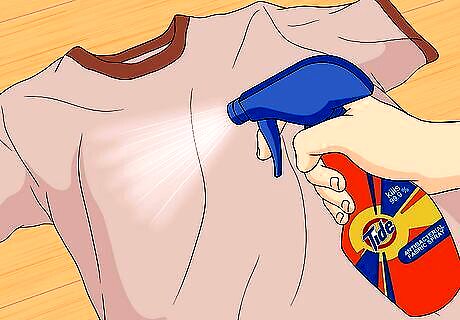
Mist your clothes with a commercial deodorizing spray. If you don’t have time to mix up a DIY deodorizer, simply use a store-bought option like Febreze or Tide Fabric Spray. With most commercial sprays, you simply spritz your musty clothes until they’re lightly dampened. Then, hang them up outside to dry.
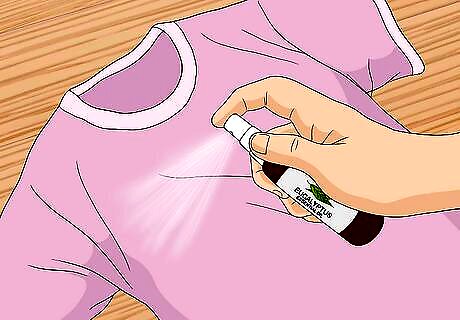
Freshen your clothes with an essential oil spray. Essential oils neutralize your smelly clothes with your favorite scent. Plus, some oils, like lavender, eucalyptus, and tea tree oil, kill bacteria. Simply fill up a spray bottle with water and add several drops of your favorite essential oil. Mist your clothes until they feel slightly damp, then hang them to dry. Or, spray your clothes with your favorite perfume or cologne.
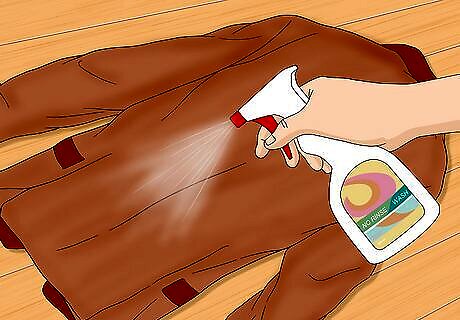
Apply a no-rinse cleaner onto your clothes. If you have a musty coat or another dry clean only item, submerging it in water isn't an option. A no-rinse cleaner is a concentrated detergent that effectively cleans the surface of your garment without completely saturating it. So, there's less of a chance that the fabric warps or gets ruined. To use most types of no-rinse cleansers: Mix a capful of detergent with the amount of water indicated on the label. Pour the mixture into a spray bottle. Spray your musty garment until it is slightly damp. Hang the garment to dry outside. If it still smells musty, repeat the process. This method wets your clothes, so don’t use this on fabrics that can’t get wet, like leather or suede.
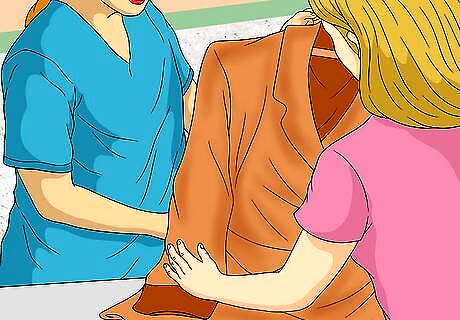
Get your clothes professionally dry cleaned. If none of the at-home methods successfully remove the musty smell on your clothes, take them to a local dry cleaner. Dry cleaners use powerful chemicals to deodorize fabric, and in most cases, they effectively get rid of mustiness. If you're concerned about having your clothing coated with chemicals, go to a "green" dry cleaner that uses liquid carbon dioxide.
Removing Mold from Clothes
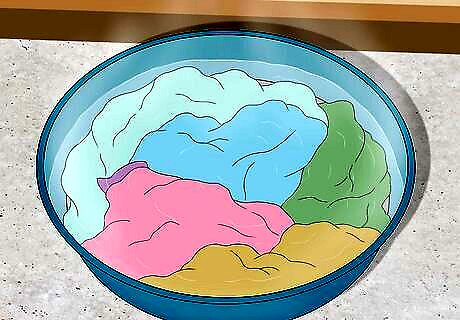
Set the clothes in boiling water for 5 minutes and then wash them. If the musty smell on your clothes is coming from spots of fuzzy mold, bring a large pot of water to boil. Place your garment in a separate, heat-safe bowl and pour the boiling water over it until it’s fully soaked. Then, let the garment sit for 5 minutes and then wring it out. Set your washer to its hottest setting, wash the garment as normal, and then hang it up outside in the sun to dry. The high heat of boiling water kills mold and removes musty smells. Use this method on items like towels, sheets, and other sturdy fabrics that can stand up to boiling water. More delicate fabrics might fall apart in boiling water.
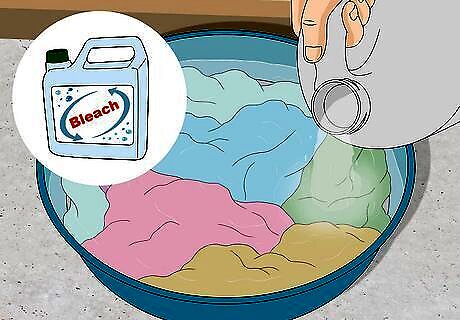
Soak your clothes in a bleach solution as an alternative. Put on a respirator mask, gloves, and move to a well-ventilated room in your home. Then, get out a large bucket and pour in ½ cup (118 ml) of bleach and 1 gallon (4 l) of water. Place your clothes in the bucket and let them soak in the bleach solution for at least 1 hour. Wash your clothes on your machine’s hottest setting and then leave them outside in the sun to dry. Bleach is an effective mold killer that also removes mustiness. Check your garment’s tag before bleaching it. If it says "Do Not Bleach," use a different method as the bleach can damage or fade the fabric. Warning: Never mix bleach and ammonia together or combine them with other cleaning agents as they can produce harmful gasses.
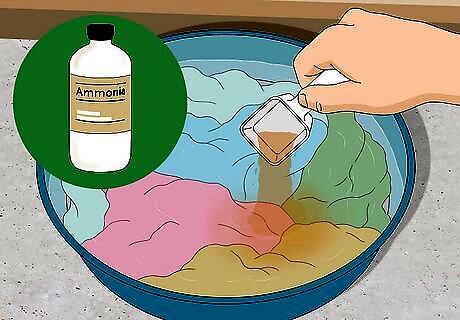
Wash your clothes with ammonia as an alternative to bleach. Put on a respirator mask and gloves and work in a well-ventilated room. Then, place your clothes in the washer and start a normal cycle without laundry detergent. When the basin is full, add 1 cup (237 ml) of ammonia to the water. Let the cycle run and then start a second cycle with detergent only. Then, hang your clothes in the sun to dry. For front-loading washers: add the ammonia to the bleach dispenser. Warning: Never mix bleach and ammonia. When combined, these chemicals create a toxic gas that is dangerous to breathe in. Wear long-sleeved clothing to prevent ammonia from getting on your skin. If you breathe in ammonia, leave the area to get fresh air. If you start to feel light-headed, call Poison Control at 1-800-222-1222 or visit Poison Control’s website.
Preventing Clothes from Smelling Musty
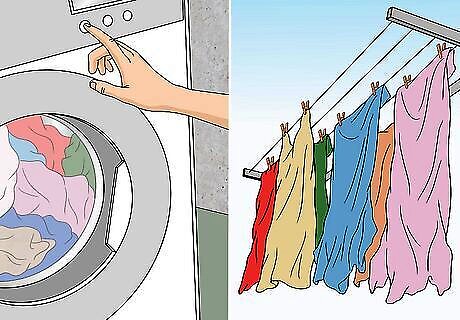
Dry your clothes completely before hanging them up. Musty odors often develop when your clothes are kept damp. Wet conditions also encourage mold and mildew to form, which can intensify the smell. Before you hang or fold your clothes, make sure they’re completely dry by running them through the dryer or hanging them on a clothesline or drying rack outside. After you wash your clothes, immediately move them into the dryer or onto a drying rack. Keeping wet clothes in your washer can encourage mold and mildew to grow on them and the inside of the washer.

Store clothes in a dry area that gets good air circulation. Humid, stale air is the perfect place for musty odors, mold, and mildew to grow. So, store your clothes in a dry, temperature-controlled area in your home. If you keep your clothes in a closet or dresser, leave the door open or the drawers slightly ajar to improve the airflow around your clothes. If you live in a humid area, place a dehumidifier in your closet or room to soak up the moist air. To further improve the air circulation, turn on your ceiling fan, open your windows, or place a standing fan in your closet or room.
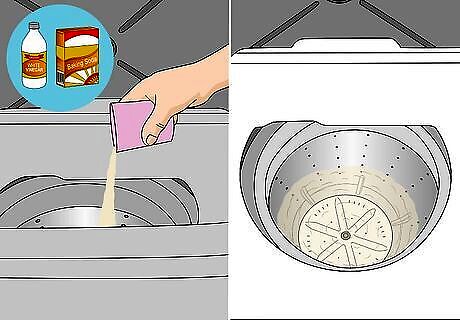
Clean your washing machine about once per month. The musty odors on your clothes might be coming from mold and mildew growing in your washer. So, keep your washing machine clean by running an empty cycle on the hottest setting about once each month. Just add 2 cups (473 ml) of vinegar and ½ cup (110 g) of baking soda into the washer’s basin to kill the mold and neutralize musty odors. If you have a front loading washer, clean the rubber gasket, or door seal, with baking soda and vinegar to remove smelly mold and mildew.
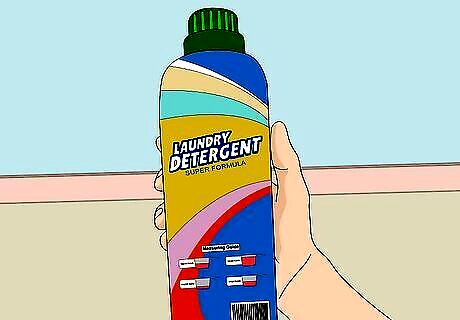
Use the recommended amount of laundry detergent for your load size. Adding more laundry detergent than you need can leave excess soap residue on your clothes that encourages bacteria, mold, and mildew to grow. When you put a load of laundry in the washer, check your laundry detergent’s label to see how much to use for the size of your wash. Using too much laundry detergent can also cause soap scum, mold, and mildew to build up inside your washer. If you have a high-efficiency (HE) washer, use HE laundry detergent to prevent residue from building up on your clothes and washer.
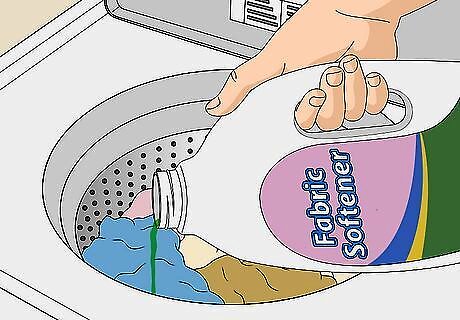
Avoid using liquid fabric softener when you wash your clothes. Fabric softener typically masks musty odors instead of neutralizing them. It can also leave behind a residue that bacteria, mold, and mildew love. If you want to add a fresh scent to your clothes, use dryer sheets in place of liquid fabric softener. Or, add several drops of your favorite essential oil onto a wool dryer ball.

Use cedar hangers in your closet. Cedar adds a fresh, woodsy scent to your clothes and absorbs moisture that can lead to musty odors or mold and mildew. Simply switch out your old hangers and place your clothes on cedar ones. Or, for a more affordable option, place cedar rings around your hangers. If you keep your clothes in a dresser, line the drawers with cedar drawer liners.















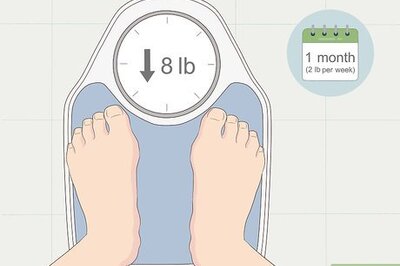




Comments
0 comment